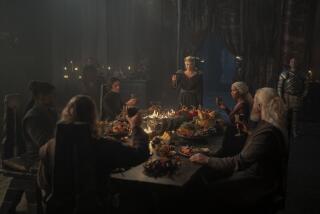5 things ‘Game of Thrones’ got wrong, according to a medieval warfare expert
- Share via
Sure, there were dragons in the air and an army of the dead on the ground, but “Game of Thrones” managed to nail it Sunday night on a few factual points of medieval warfare. It also got a few things flat-out wrong. Blame it on the entertainment needs of a TV audience.
Setting aside our very willing suspension of disbelief, we talked to a history professor Monday to get the straight scoop.
“The most realistic thing was the idea of the ‘last man standing,’ and what does the last man standing feel,” said Kelly DeVries, a specialist in medieval warfare at Loyola University Maryland. “The desperation of living, of continuing to stay alive while others are falling around you. That I thought was done tremendously.”
“When there’s a foe willing to destroy you down to the last man, woman and child,” he said, “being the last man standing has got to be pretty terrifying.”
Also on historic target was the level of destruction.
‘Game of Thrones’ Season 8, Episode 3: Who died? »
“The destruction, obviously we’re dealing with otherworldly causes of destruction in this case …,” DeVries said. “If you were under attack, especially in the later days when gunpowder [was being used] to bring down a castle, the amount of destruction at the end would probably be very similar to what we’re seeing there. Just everything burned, everything in pieces.”
And the Unsullied got a compliment for their snappy tactics.
“The way they were able to protect the retreat and then to fold back into the retreat themselves, that was very nicely done and might be very close to the way a Roman legion would behave,” DeVries said.
But from there, accuracy went downhill in favor of good old-fashioned entertainment value. Here are a few places “Game of Thrones” went historically astray — not that anyone’s complaining.
You can leave your hat on
“Nobody in their right mind would have gone into that battle without a helmet, but we’ve got to be able to see Brienne and Jaime and Gendry and all these others that are fighting without helmets,” DeVries said.
That said, we award bonus points to Grey Worm, who would never take on an enemy without his nifty helmet in place.
It’s always darkest before the dawn
The battle started in the wee hours before dawn, a reality we knew was coming back in Episode 2. And it was dark. Pitch dark. So dark even some viewers complained they couldn’t see.
“I guess it’s appropriate to fight the battle against the Night King in darkness, because it wouldn’t affect him, but it did make it a little more dark than was easy to see,” DeVries said, allowing for a bit of fantasy in the scenario.
But real life would have been a lot different.
“Nobody ever fought in the Middle Ages in the dark, because you couldn’t see, and there wasn’t enough distinction in armor that you could tell who was on what side by that. You’d have to be able to see what heraldry was being worn, or some identifying marks,” he said. “You can’t do that in the dark.”
‘Game of Thrones’ actress Bella Ramsey talks about Lyanna Mormont’s fight with the giant »
A wall is a very big weapon
DeVries said nobody in the Middle Ages would have fought outside a castle’s walls.
“Why would you? Because the walls were the most important defensive structure,” he said. “Any medieval fortification was there because of these very expensive walls, and they were hugely expensive.” He would have kept everyone inside, manning those expensive walls.
“Yes, it would have been very crowded, but nobody cares at that point.”
It might have been hard, however, to keep in a crowd like the Dothraki, because, like the Mongols they appear to be based on, “they wouldn’t cower behind walls,” he said.
FULL COVERAGE: The final season of ‘Game of Thrones’ »
“But that was a huge waste. They looked pretty across there,” he said, with their flaming swords contrasting against the darkness, “but you just lost tens of thousands of your men by sending them across against an enemy they couldn’t see. Nobody would ever go against an enemy like that.”
Big names, early expiration dates
“When some of the major leaders like George Custer in Custer’s Last Stand go down, they go down actually pretty quickly,” DeVries said. The troops are then left behind to fight for their lost leader’s cause, or maybe they just can’t get out of the place alive.
“Of course, it’s a TV thing that everyone who’s important is still alive,” he said. “The only major characters we lose are Jorah and Theon, but they both get to go out in heroic fashion. … You wouldn’t see that happen.”
Thanos has got nothing on the Night King
A lot, lot, lot of people died in the episode Sunday night. And that doesn’t bode well for Daenerys and Jon’s plans to battle Cersei for the throne.
“The last thing you want to do is take 10,000 Dothraki and make them no more,” DeVries said. “The same thing with your elite troops, the Unsullied. They completely removed their light horsemen.”
What you’ve got left, he pointed out, is only a few knights and some fighting men.
“There’s no way in the world that an army that has been devastated like that one has could now turn and go fight another campaign,” he said.
But where there’s a will, there’s a way — at least for this ragged crew — especially when there are three more episodes left in the series.
“In one way you could say all those moves worked, because they won. But do you label it victory if you really are now on the verge of defeat because you destroyed your army in doing it?” DeVries wondered. “This is the real question.”
Good thing “Game of Thrones” is anything but real.
@theCDZ on Twitter and Instagram
More to Read
The complete guide to home viewing
Get Screen Gab for everything about the TV shows and streaming movies everyone’s talking about.
You may occasionally receive promotional content from the Los Angeles Times.







